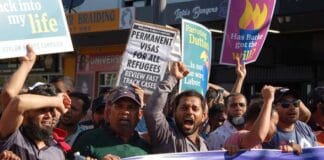Detention on Nauru is already generating misery for the refugees sent there since September 14. Housed in tents with inadequate medical care and with no access to lawyers, the asylum seekers are effectively in limbo.
So far, they have been denied the opportunity to actually apply for refugee protection—and refugee advocates have heard that the Immigration Department is telling asylum seekers on Nauru they could be detained for up to eight months before their refugee claim process even begins.
Already, the first protests have started. On October 1, a kitchen, tents and lights were damaged by a group of Iranian and Iraqi asylum seekers on Nauru. Three asylum seekers spent the night in a Nauru police station.
 But Nauru is not proving to be the “deterrent” of asylum seekers that Bowen was hoping for. By the second week of October, there were 210 asylum seekers on Nauru—210 too many, but still a long way short of the 500 that Immigration Minister Chris Bowen said would be there before the end of September.
But Nauru is not proving to be the “deterrent” of asylum seekers that Bowen was hoping for. By the second week of October, there were 210 asylum seekers on Nauru—210 too many, but still a long way short of the 500 that Immigration Minister Chris Bowen said would be there before the end of September.
Bowen has tried to keep up the momentum of the Pacific Solution 2.0 and show his determination to stop the boats by declaring Manus Island “a regional processing country” and announcing that the detention centre at Manus Island will be opening within weeks. But since the August 13 starting date for the new Pacific Solution, around 3,900 asylum seekers have arrived in Australia—more than enough to fill Nauru and Manus Island at their projected maximum capacity twice over. Even since the first asylum seekers were sent to Nauru, almost 1300 asylum seekers have arrived in Australia.
And it is possible that a challenge to Manus Island detention will be mounted by Papua New Guinea human rights lawyers in PNG’s High Court, delaying or even stopping its opening.
In the meantime, the Labor government is desperately trying to shift asylum seekers who arrived before August 13 from mainland detention centres to make room for the thousands who have arrived since August 13. As the mainland detention centres fill, and with no further capacity to send them offshore, it is only a matter of time until some of those presently threatened with being sent to Nauru will actually be processed in Australia. Bowen is trying to delay that as long as possible in the vain hope that the threat of Nauru will see a drop in the number of boats arriving.
Bowen has made much of the fact that 47 Sri Lankan asylum seekers have “voluntarily” returned to Sri Lanka. However, there are serious doubts about the circumstances in which they made the decision to return, and whether they could possibly make an informed decision. None of them have been allowed to consult lawyers or refugee advocates.
We simply don’t know what the asylum seekers were told, either of the possibilities for applying for protection visas or about Nauru. One of them has already exposed to the media that the Australian government has not made good on its promise of providing him with a $3300 repatriation package.
There have been suggestions by both the Australian and Sri Lankan governments that the Sinhalese were crew for the asylum boats, but no Sri Lankans (Sinhalese or Tamil) have ever been prosecuted for people smuggling offences.
The majority of those who supposedly voluntarily returned to Sri Lanka are from the majority Sinhalese ethnic group, but Sinhalese opponents of Sri Lanka’s Rajapaksa regime are as ruthlessly persecuted as the Tamils.
Bowen has used the returns to cast doubts over the legitimacy of all Sri Lankan asylum claims. Opposition spokesperson Scott Morrison has gone one better and called for Sri Lankan asylum boats to be intercepted and turned around at sea. But, again, the numbers speak for themselves—47 people may have “voluntarily” signed to go back but almost 4,000 have arrived and will seek asylum.
Unravelling
The contradictions of Labor’s Pacific Solution 2.0 will slowly, but surely, be exposed. No amount of care by the Salvation Army will prevent the distress and the deterioration of the mental and physical health of refugees on Nauru. The horror stories of long-term detention on Nauru will inevitably emerge.
Similarly, the frustration, uncertainty and misery inflicted on the thousands held in Australian detention centres left wondering whether or not they could be sent to Nauru will inevitably take its toll on their mental health.
In both situations, the resistance of the asylum seekers themselves will become, and already has been, a headache for Bowen and Gillard.
Labor’s Pacific Solution 2.0 has handed the political initiative to the Liberals, who are constantly demanding the re-introduction of temporary protection visas and that asylum boats be turned around.
There is almost no measure of cruelty to which the parliament is not prepared to stoop in the race to “stop the boats”. Fighting the Liberals and the threat of an Abbott government means taking the fight to the Gillard government. The “not Nauru, not Manus Island” rallies this month will help do exactly that.
By Ian Rintoul





